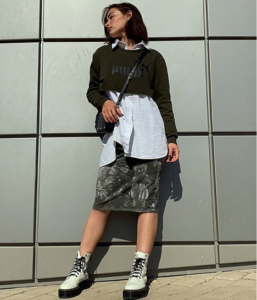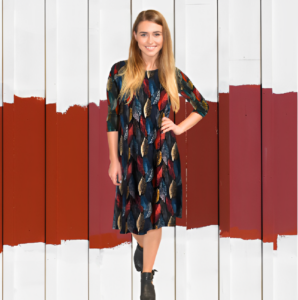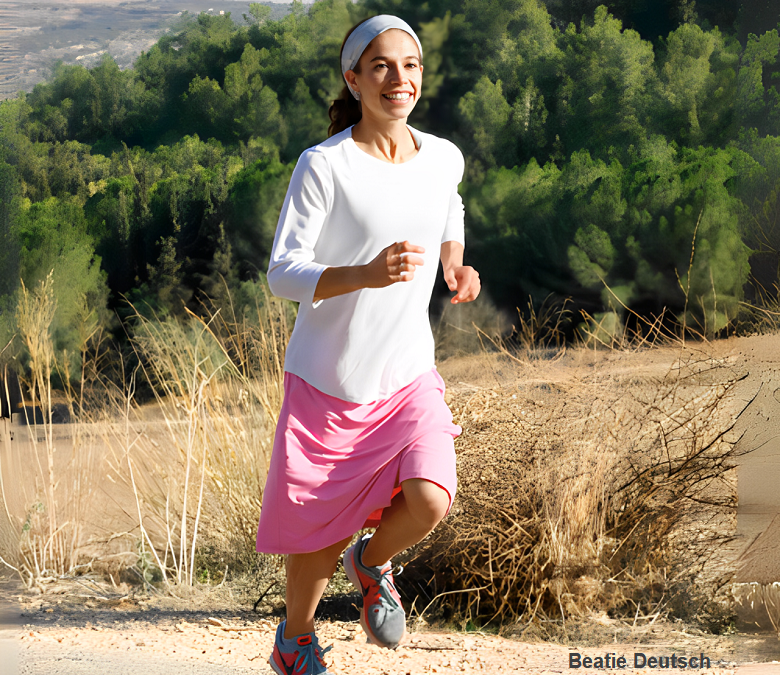
by Kosher Casual Team | Jan 2, 2025 | Kosher Casual, Layering shirts, Layering Tops, Leggings, Long Sleeve Tops, modest clothing, Modest Fashion, Religious Modesty standards, Winter, Winter Layering, workout clothing
Winter is rearing its ugly head again this year and if there is anything I disliked (growing up in the Midwest) it’s the cold, a lot. I know I’m making the unavoidable sound so dire seeing as it rolls around every year yet I still dread it. It’s hard to look chic and sophisticated when you are wearing a ski hat, a bulky sweater, mittens and snow boots!
The thing is, I dress modestly and that includes no pants! Over the years I found it is truly is possible to stay warm in a skirt in the winter months – and still look stylish by layering! This winter there are plenty of different ways to layer your outfits to create some great on-trend looks. Whether you prefer light layers or heavy statement looks, there’s no end to the choices you have when it comes to creating a layered outfit this winter. Here are some of my go-to solutions:
Cropped Jackets over Long Layers:
Pair a cropped puffer or denim jacket over a long cardigan or tunic. This creates a visually interesting contrast of lengths and textures. Pair this with a pencil skirt either knee length or midi. Keep the waist area defined while staying modest and cozy.
Dresses over Pants:
Layer a cozy sweater dress over slim-fit trousers, leggings or fitted wide-leg knit pants. Add a belt to cinch the waist if needed. Fleece-lined leggings or tights under skirts or dresses add warmth without adding bulk.
Color Blocking:
Work a different take on color blocking by layering some colorful garments. Don’t shy away from bright hues this winter – adding splashes of color (even with black) to your look will liven up an outfit. Just remember to choose complementary colors and limit it to two or three hues
Oversized Scarves as Ponchos:
Use a large wool or cashmere scarf draped over your shoulders like a cape, securing it with a brooch or belt. These offer a cozy and stylish alternative to bulky coats, especially if you like a looser silhouette.
Skirted Leggings:
Opt for leggings with attached skirt overlays, paired with knee-high boots. Add a tailored coat for structure. This adds depth and keeps a sporty, cool aesthetic.
Layered Shirts and Sweaters:
Wear a long sleeve shell under a button-down shirt, then layer with a knit vest or oversized sweater. Keep the shirt’s collar and hem peeking out for dimension. The tailored layers and a smart combinations of textures can match your preferences for minimalism with a creative twist.
When looking at layering tips for winter, it always a good idea to do trial runs beforehand to make sure your outfits really work. These are just some ideas for you to consider when it comes to winter layering tips. Get excited about winter fashion and have a really “cool” winter!

by Kosher Casual Team | Dec 2, 2024 | Color, modest clothing, Modest Fashion, Religious Modesty standards
What is the deal with red clothing? I’ve heard that red clothing is forbidden for women to wear because it’s immodest. Some recent studies confirmed that men are more attracted to women in red. So that means it’s prohibited, right? In some cultures or communities, red can be seen as bold or attention-grabbing, which may contrast with traditional views of modesty.
Some women prefer neutral tones, so red might feel a bit outside of their comfort zone. Experimenting with muted or deeper shades of red like burgundy or maroon, can feel more understated while still adding some warmth to wardrobe.
Red is sometimes viewed as not modest because of its associations with boldness, attention-seeking, and sensuality. Here are some reasons why red might be considered brazen or too forward in certain contexts:
- Psychological Impact: Red is a highly stimulating color that is often linked to passion, energy, and assertiveness.
- Cultural Perceptions: In some cultures and religious traditions, red has specific meanings related to power, sexuality, or celebration such as in China. For somber occasions, red may feel inappropriate for situations requiring restraint. Because blood is red, the color is often associated with horror!
- Historical Associations: Historically, red has often been worn by figures seeking visibility or authority, such as nobility or entertainers. A red dress was sometime seen as provocative or scandalous like Scarlet’s red dress in Gone with Wind! Red’s “reputation” may clash with the notion of modest dressing, which prioritizes not standing out.
- Gendered Symbolism: Red is sometimes associated with femininity and romantic allure, particularly in fashion and media, where it is often linked to confidence or seduction. This symbolism can make red seem too bold especially in conservative or religious settings.

Despite these perceptions, color is subjective, and red can still be worn depending on the style, fit, and personal or community standards. Here’s how red can be subtlety styled:
- Muted Shades of Red: Opting for deeper or softer shades like burgundy, wine, or aubergine can tone down the boldness of red while still incorporating it into a modern wardrobe. These shades have a more subdued feel and a more calming aesthetic.
- Balanced Styling: Pairing neutral tones like gray, black, or beige can balance the boldness of red. For example, a red top with a long skirt in a neutral color can create a more understated, modest look.
- Focusing on Fit: Wearing loose-fitting red clothing rather than tight or revealing garments can ensure that the focus remains on the style of the outfit, rather than the attention-grabbing nature of the color.
- Red can be worn as an accent color in accessories instead a clothing item. Jewelry, scarves, belts and shoes in red can be tasteful alternative options and make a great fashion statement.

Would you ever consider incorporating red into your wardrobe, or is it too far from your aesthetic?

by Kosher Casual Team | Sep 22, 2024 | modest clothing, Religious Modesty standards, Running Skirts, Sports Skirt, workout clothing
Modest Skirt Wearers Can Run Fast!!!
Can I run in a skirt? Absolutely, you can run in a skirt! Many people find it comfortable and stylish. Just make sure it’s a design that allows for movement, like a skort or a running skirt with built-in shorts. It’s all about what makes you feel good while you run! Modest running skirts offer several advantages for those who prefer a more covered style while staying active. Those who prioritize modesty for personal, cultural and religious reasons can still fully enjoy exercise, outdoor recreation or leisure activities.
Several famous female runners have worn skirts during races, either for comfort, style, or sponsorship reasons. Some of them include:
Deena Kastor, Shalane Flanagan and Joan Benoit Samuelson long distance runners and Olympic medalists- have all trained and worn running skirts in races. Beatie Deutsch is an American-Israeli marathon runner who lives in Israel. An Orthodox Jewish mother of five, she only wears sport skirts with leggings or shorts. She has competed in marathons all over Israel and in Berlin, Germany, Tokyo, Japan, Seville, Spain and Cape Town, South Africa often winning first or second place!
How to Select Great Running Skirts
Skirt Design
Look for skirts specifically designed for athletic activities and cuts that allow for a full range of motion.
Choose a skirt length that doesn’t impede your stride, knee-length or slightly above can be ideal. Ensure the fit is not too tight around the hips and thighs to allow for easy movement. Select a length that you find comfortable and that provides adequate coverage for your activity. Find a style that’s versatile! A skirt suitable for running and can be worn during the day with a t-shirt as well as by night with a blouse.
Fabrics
Many sport skirts now are made with moisture-wicking fabric – keeping you dry and comfortable by drawing sweat away from the skin. Some have mesh panels or vents that enhance airflow and prevents chafing.
Four-way stretch fabric offers maximum stretch and durability and will withstand the rigors of training and racing. Another great feature is fabrics that offer UVF protection from the sun. Fabrics should be lightweight and but also opaque (not see through), there are also heavier weight fabrics for fall and winter.
Features
Pockets, who doesn’t love pockets! Who wants to carry a purse? Deep pockets with zippers that have enough room for a cell phone or keys are essential. Another great feature in sport skirts are adjustable waistbands either stretch elastic waistbands or drawstring.
Sport/Swim Skirts should be made for with double stitched seams and hems to be resilient on concrete, hard ground and a range of activities and travel. For early morning or evening runs clothing with reflective elements for safety and visibility is essential. Finally for marathon runners, test your skirt with a shorter run or jog to ensure it’s comfortable and doesn’t cause any issues before running.
Yes, modest skirt wearers can run fast, but there are some aspects to consider to ensure comfort and safety. Many brands offer a variety of styles and fits to cater to different preferences and needs.
What do you want in a running skirt?

by Kosher Casual Team | Jul 14, 2024 | Apostolic Pentecostal, modest clothing, Religious Modesty standards
What is the Difference in Modest Dress Code between Orthodox Jewish and Apostolic Pentecostal Women?
The modest dress codes for women amongst Orthodox Jews and Apostolic Pentecostals share a common commitment to covering the body, but they differ in specific practices and interpretations influenced by their respective religious observances and traditions.
Orthodox Judaism reflects a desire to maintain humility and respect in appearance, adhering closely to interpretations of Jewish law (Halacha) regarding dress and personal conduct. There is an emphasis is on avoiding tight or revealing clothing.
Pentecostals emphasize external reserve as a reflection of inner spirituality and separation from worldly influences Dress standards are often articulated by church leadership and vary somewhat among different congregations.
Clothing:
Orthodox Jewish women typically wear long skirts or dresses that cover the knees. The clothing also covers the elbows and collarbones, often with sleeves extending to the wrists. Necklines are kept above the collar bone and low cut clothing is avoided.
Apostolic Pentecostal women typically wear dresses or skirts that extend below the knees. Pants or shorts are generally avoided due to understandings of religious standards. Sleeves are often longer, covering at least shoulders or elbows. Cleavage cover is encouraged.
Hair Covering:
Most Orthodox Jewish women typically cover their hair after marriage. This can be done using wigs (Sheitels), scarves (tichels), hats, or snoods. The type of hair covering differs by community. Unmarried women do not cover their hair.
In some Apostolic Pentecostal communities, women might choose to cover their hair with a scarf or other head covering during prayer, worship services, or other religious ceremonies. This Apostolic Pentecostal women may wear head coverings more broadly as a sign of submission to their spouse, religious leaders and God.
Cultural Influence and Flexibility:
Orthodox Jewish Women: Dress code can vary significantly based on the specific community (e.g., Hasidic, Yeshivish, Modern Orthodox, and Israeli National Religious), level of religious observance and the cultural subsets of Western Ashkenazi Jews and Eastern Sephardic Jews.
Apostolic Pentecostal Women: Generally adhere to a more uniform standard of dress across different congregations, with similarities in practice. Southern states tend to be more conservative, while Western and Northeastern states might incorporate more contemporary elements. Northern and Midwestern states often find a balance between these extremes.

Adornment:
Orthodox Jewish Women: There are no specific prohibitions against makeup or jewelry, although more conservative communities may discourage excessive adornment.
Apostolic Pentecostal Women: Avoid makeup and jewelry entirely, emphasizing a natural and simple appearance.
Body Modification
Both Orthodox Jewish and Apostolic Pentecostal Women do not allow tattoos!
Interestingly both groups use the same biblical reference from Leviticus 19:28: “You hall not make gashes in your flesh for the dead, or incise any marks on yourselves: I am the Lord.” This verse explicitly prohibits the practice of making permanent marks on the body.
In summary, while both Orthodox Jewish and Apostolic Pentecostal women adhere to similar modesty standards in dress, there are some variations in hair coverings and accessories. Each group follows the specific teachings and interpretations of Torah/Bible/Scriptural, the practices of local and regional traditions, and in sometimes distinct cultural backgrounds.

by Kosher Casual Team | Jul 14, 2024 | modest clothing, Modest Dresses, Modest Fashion, Religious Modesty standards
How to Teach Girls to Dress Modestly!Teaching girls make clothing choices that are respectful, appropriate for various settings, and aligned with societal values in today’s world is not always easy. We want to prepare our children for a world where external appearances can influence perceptions. Here are some strategies for teaching girls to dress modestly:
Start Early: Begin teaching girls about appropriate clothing choices from a young age. Even children as young as three can understand simple concepts as they learn to dress themselves.
Explain the Reasons: Help girls understand why the way we dress is important and how it contributes to their self-respect, dignity, and relationships with others. Talk about how your religious beliefs, culture, environment and values. It is crucial in navigating these discussions to foster open and honest communication.
Set Clear Guidelines: Establish clear guidelines for appropriate attire in different settings, such as at home, school, religious gatherings, and social events. Offer them guidance on selecting clothing items that provide adequate coverage and are respectful of their bodies.
Encourage Self-Expression: Allow girls to express their personal style and preferences within the boundaries of what’s acceptable. Encourage them to choose clothing that reflects their individuality while also respecting cultural norms and social expectations.
Teach Dress Codes: Familiarize girls with dress codes at their school, religious institution, or other places they frequent. Help them understand the reasons behind these dress codes and how to comply with them while still expressing some individuality.
Provide Feedback: Offer constructive feedback and guidance when girls are selecting clothing or putting together outfits. Encourage them to consider factors such as fit, length, shirt necklines, and overall coverage when making clothing choices. 
Be a Role Model: Lead by example with your own clothing choices and behavior. Girls often learn from their mothers. Teach your daughters to dress with confidence and self-assurance.
Discuss Media Influence: Talk to girls about the influence of media, fashion trends, and peer pressure on clothing choices. Help them develop critical thinking skills to navigate messages about beauty, body image and self-worth in the media.
By incorporating these strategies into your parenting approach, you can help girls develop a sense of modesty and make respectful clothing choices that reflect their values, individuality, and self-respect.














